
The Vital Role of Bookkeeping for Attorneys’ Financial Health
Table of Contents In the complex world of law, attorneys face a unique set of financial challenges. From managing trust

In a previous blog, we talked about the three types of small business accounting. One of them was financial accounting, and for this type, you must follow the steps of the accounting cycle. However, before you do that, you should set up the accounting system.
To review, the steps of the accounting cycle are:
In this blog, we will explain how to set up your accounting system to be used in the accounting cycle for a small business.
Related Post: 3 Types of Small Business Accounting
A chart of accounts is an index of all the accounts where your business files financial information. In the chart of accounts, you should create a numbering system for each category so you can keep it organized, and they should be listed in chronological order.
There are five categories to use on a chart of accounts:
Always keep source documents of your transactions, so you can have evidence that a transaction occurred. This could be invoices, canceled checks, receipts, purchase orders, and other documents.
That brings us to creating journal entries. These entries are stated in debits and credits. Journal entries should be entered as soon as your business makes a transaction. The entries should be classified by their account, set up in the chart of accounts.
At the end of the accounting cycle, you must transfer the journal entries to the general ledger. The entries are listed in a summary form, where the debits and credits are separated into their separate accounts according to the chart of accounts.
After you transfer the journal entries to the general ledger, you can prepare the trial balance. For this, you total out the debits and credits to make sure they are balanced for the current accounting period.
After preparing the trial balance, you should adjust the revenues and expenses in the journal entries to the accounting period to which they actually occurred. There are five types of adjustments: accrued revenues, accrued expenses, prepaid expenses, and depreciation. These adjustments will impact your final monthly balance.
Now you can prepare the financial statements. Take the information from the accounting journal and the general ledger and use those to develop the following statements in this order:
At the end of the accounting cycle, you can now create the closing entries. This is when you create journal entries to set the balance of temporary accounts to zero so you can begin the next accounting period. You should close the following accounts:
These accounts should remain open because their ending balances are the beginning balances for the next accounting period:
Now that you know the many parts of your accounting system, you can begin your accounting cycle for your small business.
Need assistance with your financial accounting? At Assemblage LLC, we offer bookkeeping and accounting services to small and medium-sized businesses!
We can assist you with your financial statements so you can better understand the numbers and stay organized. Contact us today!

Table of Contents In the complex world of law, attorneys face a unique set of financial challenges. From managing trust

Table of Contents Small businesses often encounter a unique set of challenges as they seek to expand. From limited resources